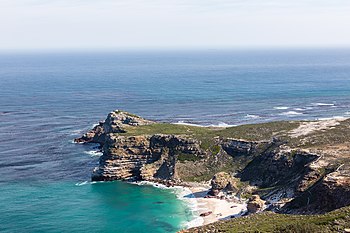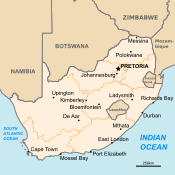
Back Kaap die Goeie Hoop Afrikaans Gōdes Hyhtes Næss ANG رأس الرجاء الصالح Arabic ܪܝܫܐ ܕܣܒܪܐ ܛܒܐ ARC رأس الرجاء الصالح ARZ Cabu de Bona Esperanza AST Ümid burnu Azerbaijani Kabo kan Marhay na Paglaom BCL Мыс Добрай Надзеі Byelorussian Мыс Добрай Надзеі BE-X-OLD

The Cape of Good Hope (Afrikaans: Kaap die Goeie Hoop [ˌkɑːp di ˌχujə ˈɦuəp])[a] is a rocky headland on the Atlantic coast of the Cape Peninsula in South Africa.
A common misconception is that the Cape of Good Hope is the southern tip of Africa, based on the misbelief that the Cape was the dividing point between the Atlantic and Indian oceans. In fact, the southernmost point of Africa is Cape Agulhas about 150 kilometres (90 mi) to the east-southeast.[1] The currents of the two oceans meet at the point where the warm-water Agulhas current meets the cold-water Benguela current and turns back on itself. That oceanic meeting point fluctuates between Cape Agulhas and Cape Point (about 1.2 kilometres (0.75 mi) east of the Cape of Good Hope).
When following the western side of the African coastline from the equator, however, the Cape of Good Hope marks the point where a ship begins to travel more eastward than southward. Thus, the first modern rounding of the cape in 1487 by Portuguese explorer Bartolomeu Dias was a milestone in the attempts by the Portuguese to establish direct trade relations with the Far East (although Herodotus mentioned a claim that the Phoenicians had done so far earlier).[2] Dias called the cape Cabo das Tormentas ('Cape of Storms'; Dutch: Stormkaap), which was the original name of the cape.[3]
As one of the great capes of the South Atlantic Ocean, it has long been of special significance to sailors, many of whom refer to it simply as "the Cape".[4] It is a waypoint on the Cape Route and the clipper route followed by clipper ships to the Far East and Australia, and still followed by several offshore yacht races.
The term Cape of Good Hope is also used in three other ways:
- It is a section of the Table Mountain National Park, within which the cape of the same name, as well as Cape Point, falls. Prior to its incorporation into the national park, this section constituted the Cape Point Nature Reserve.[5]
- It was the name of the early Cape Colony established by the Dutch East Indies Company in 1652, on the Cape Peninsula.
- Just before the Union of South Africa was formed, the term referred to the entire region that in 1910 was to become the Cape of Good Hope Province (usually shortened to the Cape Province).
Cite error: There are <ref group=lower-alpha> tags or {{efn}} templates on this page, but the references will not show without a {{reflist|group=lower-alpha}} template or {{notelist}} template (see the help page).
- ^ "Cape of Good Hope, South Africa – 360° Aerial Panoramas". Archived from the original on 2011-10-08. Retrieved 2017-02-03.
- ^ The first circumnavigation of Africa Archived 2015-10-16 at the Wayback Machine. livius.org
- ^ Sarah Mytton Maury (1848). Englishwoman In America. p. 33.
- ^ Along the Clipper Way, Francis Chichester; page 78. Hodder & Stoughton, 1966. ISBN 978-0-340-00191-2
- ^ "Map of the Park, showing the Cape of Good Hope section (retrieved 27 March 2010)". Archived from the original on 1 December 2022. Retrieved 28 March 2010.

